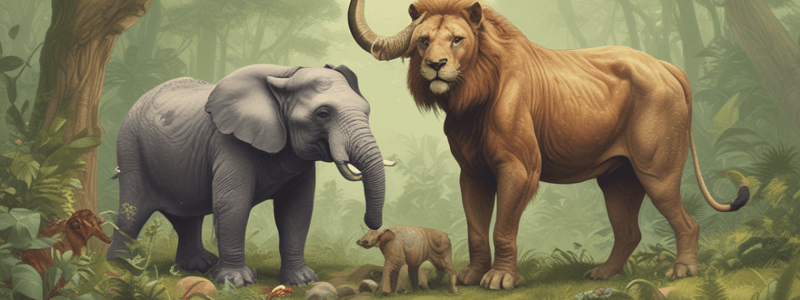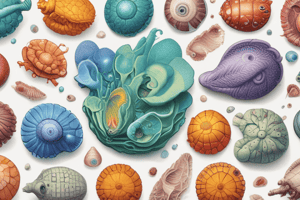Podcast
Questions and Answers
What is a characteristic that distinguishes animals from other organisms?
What is a characteristic that distinguishes animals from other organisms?
- Presence of cell walls
- Ability to photosynthesize
- Autotrophic nutrition
- Ability to capture prey (correct)
From which group of protists are animals thought to have evolved?
From which group of protists are animals thought to have evolved?
- Flagellated protists
- Choanoflagellates (correct)
- Sponges
- Cnidarians
What is the term for the period of rapid animal diversification?
What is the term for the period of rapid animal diversification?
- Bilateral symmetry
- Protostome development
- Cambrian explosion (correct)
- Radial symmetry
What is the main advantage of bilateral symmetry in animals?
What is the main advantage of bilateral symmetry in animals?
What is the term for the succession of cell division without growth between divisions in animal zygotes?
What is the term for the succession of cell division without growth between divisions in animal zygotes?
Which group of invertebrates has a lophophore for feeding or a trochophore larval stage?
Which group of invertebrates has a lophophore for feeding or a trochophore larval stage?
Which invertebrate group has a flat body form for a large surface area?
Which invertebrate group has a flat body form for a large surface area?
What is the term for the cavity surrounded by tissues derived from mesoderm in animals?
What is the term for the cavity surrounded by tissues derived from mesoderm in animals?
What is the term for the developmental process in which the blastopore becomes the anus?
What is the term for the developmental process in which the blastopore becomes the anus?
Which phylum is the only one that includes vertebrates?
Which phylum is the only one that includes vertebrates?
What is the primary function of the capillaries in the human cardiovascular system?
What is the primary function of the capillaries in the human cardiovascular system?
What is the difference between open and closed circulatory systems?
What is the difference between open and closed circulatory systems?
Which of the following is NOT a part of the innate immune response?
Which of the following is NOT a part of the innate immune response?
What is the function of the right ventricle in the human cardiovascular system?
What is the function of the right ventricle in the human cardiovascular system?
Which of the following is a characteristic of atherosclerosis?
Which of the following is a characteristic of atherosclerosis?
What is the purpose of the Malpighian tubules in insects?
What is the purpose of the Malpighian tubules in insects?
What is the difference between positive and negative pressure breathing?
What is the difference between positive and negative pressure breathing?
Which of the following is a benefit of immunization?
Which of the following is a benefit of immunization?
What is the function of the kidneys in vertebrates?
What is the function of the kidneys in vertebrates?
Which of the following is a type of nitrogenous waste produced by animals?
Which of the following is a type of nitrogenous waste produced by animals?
Which of the following characteristics is common to all chordates?
Which of the following characteristics is common to all chordates?
Which type of tissue is responsible for holding many tissues and organs together in place?
Which type of tissue is responsible for holding many tissues and organs together in place?
What is the main function of the hypothalamus in the body?
What is the main function of the hypothalamus in the body?
What is the primary function of the small intestine in the digestive system?
What is the primary function of the small intestine in the digestive system?
Which of the following animals is an example of a vertebrate?
Which of the following animals is an example of a vertebrate?
What is the main function of the endocrine system in the body?
What is the main function of the endocrine system in the body?
Which type of muscle is responsible for voluntary movement?
Which type of muscle is responsible for voluntary movement?
What is the main function of the pancreas in the digestive system?
What is the main function of the pancreas in the digestive system?
What is the primary function of the liver in energy storage?
What is the primary function of the liver in energy storage?
Which of the following is a characteristic of arthropods?
Which of the following is a characteristic of arthropods?
What is the primary function of the glomerulus in the nephron?
What is the primary function of the glomerulus in the nephron?
What is the role of ADH in the nephron?
What is the role of ADH in the nephron?
What is the main difference between the endocrine system and the nervous system?
What is the main difference between the endocrine system and the nervous system?
What type of hormone is insulin?
What type of hormone is insulin?
What is the function of the posterior pituitary?
What is the function of the posterior pituitary?
What is an example of positive feedback in hormone regulation?
What is an example of positive feedback in hormone regulation?
What is the function of the hypothalamus in the endocrine system?
What is the function of the hypothalamus in the endocrine system?
What is the function of the Bowman's capsule in the nephron?
What is the function of the Bowman's capsule in the nephron?
What is the term for the regulation of hormone production by opposing hormones?
What is the term for the regulation of hormone production by opposing hormones?
What is the primary function of the nephron?
What is the primary function of the nephron?
Flashcards are hidden until you start studying
Study Notes
Animal Diversity
- Common characteristics of animals:
- Can move and capture prey
- Multicellular
- No cell walls
- Heterotrophic
- Eukaryotes
- Animals are thought to have evolved from flagellated protists, with choanoflagellates being the closest living relatives
- The Cambrian explosion marks a period of rapid animal diversification
Animal Body Plan
- Radial symmetry vs. bilateral symmetry
- Most animals evolved to have bilateral symmetry, which allows for faster movement and formation of a head with sensory organs and central nervous system
Embryo Development
- Animal zygotes undergo cleavage, a succession of cell divisions without growth between divisions
- Cleavage leads to the formation of a blastula, often in the form of a hollow ball of cells
Animal Tissues
- Only a few groups of animals have no tissue (e.g., sponges)
- Most animals have germ layers that give rise to tissues and organs
- Diploblastic: ectoderm and endoderm
- Triploblastic: ectoderm, endoderm, and mesoderm
- Body cavity: coelom (a cavity surrounded by tissues derived from mesoderm), hemocoel (filled with hemolymph), or no cavity at all (e.g., flatworms)
Protostome vs. Deuterostome Development
- In protostome development, the blastopore becomes the mouth
- In deuterostome development, the blastopore becomes the anus
- Examples: echinoderms and chordates
Chordata and Invertebrates
- Chordata is the only phylum of animals that includes vertebrates
- Most other animals are invertebrates
- Invertebrates: animals without a backbone
- Examples: Porifera (sponges), Cnidarians, Lophotrochozoans, Flatworms (Platyhelminthes), Molluscs, Annelids, Ecdysozoans, Nematodes, Arthropoda
Vertebrate Animals
- Common characteristics of chordates:
- Bilateral
- Deuterostome development
- Mostly vertebrates with two groups of invertebrates
- Four characteristics of chordate embryos:
- Notochord
- Dorsal nerve cord
- Pharyngeal pouches (slits)
- Post-anal tail
- Vertebrate examples:
- Lancelets and tunicates (invertebrate chordates)
- Hagfishes and lampreys (lacking jaws)
- Sharks and rays (oil in the liver to maintain buoyancy)
- Ray-finned and lobe-fin fish (swim bladder for buoyancy)
- Amphibians (need water and land for living, metamorphosis, frogs and salamanders)
- Reptiles (scales, shelled and amniotic eggs, ectothermic)
- Birds (endothermic, direct descendants of dinosaurs)
- Mammals (mammary glands, hair, endothermy)
Animal Form and Function
- Tissues:
- Groups of cells with similar appearance and function
- Four types: epithelial, connective, muscle, and nervous tissue
- Epithelial tissue:
- Covers the outside of the body and lines organs and cavities
- Connective tissue:
- Holds tissues and organs together
- Examples: tendons, ligaments, bone, adipose tissue, blood
- Muscle tissue:
- Responsible for movement and contraction
- Three types: skeletal, smooth, and cardiac
- Nervous tissue:
- Functions in receipt, processing, and transmission of information
- Two types: neurons (nerve cells) and glial cells (support cells)
Animal Nutrition
- Variation in diet:
- Herbivores
- Carnivores
- Omnivores
- Food processing:
- Ingestion
- Digestion
- Absorption
- Elimination
- Digestive system:
- Mouth
- Pharynx
- Esophagus
- Stomach
- Small intestine
- Large intestine
- Energy storage:
- Liver and muscle cells (glycogen)
- Excess energy stored in fat
Circulation and Respiration
- Open and closed circulatory systems:
- Insects, arthropods, and some molluscs: open circulatory systems with hemolymph
- Annelids, cephalopods, and vertebrates: closed circulatory systems
- Human cardiovascular system:
- Heart
- Blood vessels
- Arteries
- Veins
- Capillaries
- Blood circulation:
- Right ventricle pumps blood to lungs
- Oxygen-rich blood returns to left atrium
- Blood flows into left ventricle and is pumped out to body
- Gas exchange:
- Occurs in capillary beds
- Oxygen-poor blood from body is channeled into vena cava and reaches right atrium
Immune System
- Examples of pathogens:
- Viruses
- Bacteria
- Fungi
- Innate immunity:
- Non-specific
- Active immediately upon infection
- Barrier defenses (skin, mucus, body fluids)
- Cellular defense (neutrophils, macrophages, dendritic cells, eosinophils, natural killer cells)
- Inflammation
- Interferons
- Adaptive immunity:
- Activated after innate response
- Develops more slowly
- Enhanced by previous exposure to pathogen
- T cells and B cells
- Primary vs. secondary immune response:
- Immunization: protection provided by second immune response
- Vaccines are used for immunization
Osmoregulation
- Osmoregulation:
- Controls solute concentrations and balances water gain and loss
- Animal's nitrogenous waste:
- Consumption of proteins and nucleic acids causes nitrogenous waste
- Animals need to remove nitrogenous waste products by excretion
- Examples: ammonia, urea, uric acid
- Key functions of most excretory systems:
- Filtration
- Reabsorption
- Secretion
- Excretion
- Excretory systems:
- Malpighian tubules (used by insects and other terrestrial arthropods)
- Kidney (the excretory organs of vertebrates and some other chordates)
Hormones
- Hormone:
- A secreted molecule that circulates through the body and stimulates specific cells
- Communication and control in animals:
- Endocrine system: chemical signaling by hormones
- Nervous system: a network of specialized cells (neurons) that transmit signals along dedicated pathways
- Feedback regulation:
- Negative feedback: reduces the initial stimulus
- Positive feedback: reinforces a stimulus to produce an even greater response
- Hormone examples:
- Oxytocin
- Testosterone
- Estrogen
- Progesterone
- Growth hormone
- Thyroid hormone
Studying That Suits You
Use AI to generate personalized quizzes and flashcards to suit your learning preferences.




